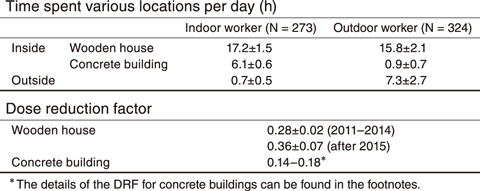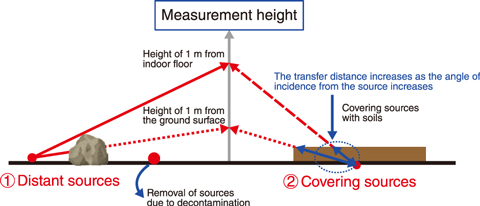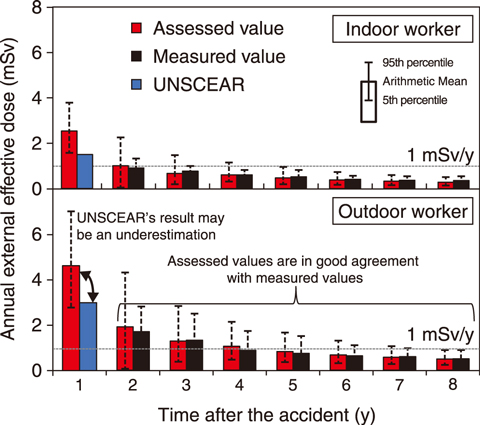Table 1-2 Time spent in various locations and dose reduction factor


Fig.1-35 Distribution of radiation sources after decontamination

Fig.1-36 Comparison of assessed values with measured values and with UNSCEAR’s assessment
External exposure from radionuclides deposited on the ground surface has been the dominant exposure pathway for humans in the area affected by the accident at TEPCO’s Fukushima Daiichi NPS. To assess the doses from this pathway, it is necessary to clarify (i) exposure rates and (ii) the time spent in various locations in daily life.
In this study, locations were classified into three types: inside a wooden house, inside a concrete building, and outside. Under this classification, the time spent by residents in these locations in the city of Fukushima was studied. In addition, to evaluate the dose reduction factor (DRF), the ambient dose equivalent rate was measured inside and outside the houses. Furthermore, a personal dosimeter was distributed to the survey participants, and individual doses were measured.
From these measurements and surveys, the time spent in each classified location and the DRF for Japanese wooden houses were clarified; a summary of the results is shown in Table 1-2. The DRF is defined as the ratio of the ambient dose equivalent rate measured inside to that measured outside a house. All indoor and outdoor measurements were performed 1 m above the floor and above the ground surface, respectively.
The ambient dose equivalent rates measured indoors and outdoors decreased by decontamination. Further, the DRFs increased after 2015, when decontamination in Fukushima was generally completed, due to the increased contribution of distant or covered radiation sources. As described in Fig.1-35, radiation from these sources is shielded by obstacles on the ground or ground covering (e.g., soil). The shielding effect decreases as the angle of incidence from the source increases. Therefore, when decontamination is performed, the decrease of dose rate measured 1 m above the indoor floor is less than that measured 1 m above the ground surface. Thus, the DRF increased after decontamination.
Doses to the public were assessed using the results shown in Table 1-2 as the product of the ambient dose equivalent rate and the time spent in each location. The dose rate for each location was calculated by multiplying the observation results of the ambient dose equivalent rate measured outside by the DRF.
The results of the developed dose assessment model are presented and compared with the measured data and the results of United Nations Scientific Committee on the Effects of Atomic Radiation (UNSCEAR)’s project in Fig.1-36. As the assessment results are in good agreement with the measured values in Fukushima, the developed model was validated. In comparing the developed model to the results provided by UNSCEAR, their result may be an underestimation, as the UNSCEAR assessment used a value of 0.15 as a DRF for wooden houses in the first year after the accident. Finally, in comparison with the national long-term dose target of 1 mSv/y, no participants exceeded this dose in Fukushima eight years after the accident, based on the results of the measured values and developed model.
(Shogo Takahara)
<Previous: 1-17 | Next: 2 Research on Nuclear Safety and Emergency Preparedness>